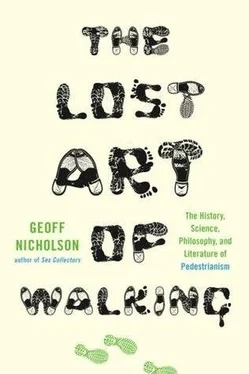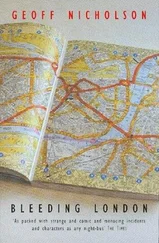Disappointed, we left the Land Cruiser and walked around. We didn’t bother to take water or even sun hats with us. There seemed to be no need. We weren’t even doing anything so definite as ‘going for a walk’. We were just wandering about. We investigated some old tailings dumps, peered into a lethal-looking open mine shaft. If we went more than a mile I’d be surprised.
Before long we decided to head back to the Land Cruiser. After we’d walked for a while in what we felt sure was the direction of the vehicle, we realized we were mistaken. We didn’t arrive at the vehicle. In fact, now that we looked around us more critically, we realized the Land Cruiser was nowhere to be seen. That didn’t seem right; it scarcely seemed possible. We set off in another likely-looking direction, and that didn’t take us to the Land Cruiser either. Above all, it seemed plain odd and incomprehensible, but it was frightening, too, and we realized it was perfectly possible that both our attempts to get back to the vehicle might in reality have taken us farther away.
We felt like idiots. If we’d been heading out to do some serious desert walking we’d have done all the right things: studied maps, carried a good supply of water, brought a compass. As it was, we had nothing.
It seemed absurd that we could get lost in territory like this. It was a tame, flat, unexceptional, unthreatening bit of desert, but that was a large part of the problem. It was a landscape without landmarks, and certainly without any high place you might climb up to in order to get your bearings. This terrain was featureless, with every bush and rock looking very much like every other bush and rock. Then we noticed a lot of stripped animal bones lying on the ground, and we saw a skull, the kind you see in cartoons that opens its jaw and says, ‘You’ll be sorry’. We realized just how bad and serious our situation was.
To cut a short story even shorter, we did, of course, eventually find our way back to the Land Cruiser. It had everything to do with good luck and nothing at all to do with good judgment, and I know that the story might very easily have turned out quite differently and that I’d be in no position to write it. Perhaps we didn’t altogether deserve to survive.
We wandered aimlessly for what seemed an age, but which, as I said, was only a couple of hours, and suddenly we spotted the open mine shaft we’d seen before. From there we were able to find our way back to the Land Cruiser. In some ways it was an anticlimax, though not an unwelcome one. It taught me that simply walking off into the desert is a very stupid thing to do, but perhaps that’s something I shouldn’t have needed to learn. Walking lost in the desert was an entirely unspiritual experience. It did not make me feel at one with anything, least of all nature.
♦
In retrospect I realize what I should have done was to choose a spot on the ground, any spot, and walk a spiral course moving outward in ever-expanding circles. That way I would inevitably have come to the Land Cruiser sooner or later.
If you had been watching this from the air you might possibly have thought that I was performing a labyrinth walk, the most ancient form of spiritual walking, and the New Agers have naturally picked up on it. Labyrinth walking has figured in rituals and religions from Iceland to Sri Lanka, from Tunisia to Sumatra, from India to Brazil.
In common parlance the words maze and labyrinth tend to be interchangeable — however, there’s a significant difference. Whereas a maze contains multiple paths and dead ends, and therefore many opportunities for getting lost, the labyrinth contains just one path. By taking it you inevitably get to the center. In a maze you encounter high walls or hedges that conceal the path and the pattern. Labyrinths generally have no walls, no concealment. They’re marked out on the ground in two dimensions, in earth, sand, or tile. If you chose, you could walk straight across to the center, avoiding the marked path completely, although naturally this is frowned upon by serious labyrinth walkers. Walking around a maze is a form of puzzle solving — walking around a labyrinth is a spiritual exercise. The notion that there’s only one true path is of course attractive to believers. You cannot get lost in a true labyrinth.
Virginia Westbury, author of Labyrinths: Ancient Paths of Wisdom and Peace , asked the many labyrinth walkers she encountered what they thought labyrinths were ‘for’. The replies she got included ‘meditation, celebration, spiritual connection, talking to God, talking to spirits, self-exploration, healing, sensing ‘energy’ wisdom, worship, divination, inner peace, forgiveness, transformation and communicating with others’. Is there nothing a labyrinth can’t do?
There are Christian labyrinths inside the French cathedrals of Chartres, Reims, and Amiens. The one at Chartres is the oldest, dating from the early thirteenth century. These are pavement labyrinths, set into the cathedral floors, and the original symbolic intentions have largely been lost. It seems they may have been as much concerned with seasonal rituals as with prayer walking, but we do know that in the eighteenth century pilgrims would walk around these labyrinths on bended knee while praying, as a penance.
There are currently a number of prisons in the United States that have installed labyrinths in their exercise yards. A few years ago the authorities at Monterey County Jail in Salinas, California, spent three thousand dollars on a portable version, a purple labyrinth painted on canvas, ninety feet across. It was unrolled from time to time and prisoners walked its path.
Prisoners reported feeling calm and at peace having walked it, though Cynthia Montague, one of the jail’s chaplains, reckoned its chief function was metaphoric. The labyrinth walk was about getting and staying on track, returning to the narrow if not the straight. Montague said, ‘If you accidentally step off the path and go onto a different part of the path, you might find yourself heading back out. But you’re allowed to start over again and keep at it’.
The most famous of all labyrinth walkers must surely be Theseus, who walked into the labyrinth in Crete to slay the minotaur. In order to avoid getting lost he used Ariadne’s ball of golden thread to trace his steps. This means, of course, that he was actually in a maze rather than a true labyrinth.
Instead of a golden thread, Hansel and Gretel tried leaving a trail of bread crumbs to stop themselves from getting lost, although you could argue that they were not so much lost as abandoned by their father. And in fact they did perform considerable walking feats. The Grimms’ fairy tale has them dumped in the middle of the forest and then ‘walking all day and all night’ to get home.
♦
The Death Valley ‘49 ers, of 1849, the desert’s most famous lost pioneers, had neither golden thread nor bread crumbs, but they did have a map promising a shortcut through the desert, via the Walker Pass, taking five hundred miles off their journey from Salt Lake City to California, where the Gold Rush was in full swing. The phrase ‘I know a shortcut’ should strike fear in the heart of any serious walker.
The ‘49 ersstarted out as part of an expedition led by Captain Jefferson Hunt, under the auspices of the Mojave San Joaquin Company, known as the Mojave Sand Walking Company, a name that gives me pleasure every time I think of it, although this started out as a wagon train rather than a walking expedition.
Hunt’s progress was too slow for some, and there were various splits and regroupings, some temporary and some permanent, before a faction known as the Bennett-Arcane party, following the dubious shortcut map, at last found themselves lost, stranded, exhausted, and helpless in the heart of what is now Death Valley.
Читать дальше












